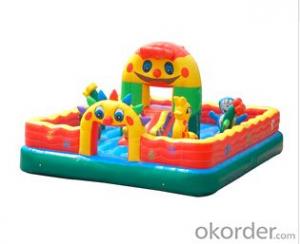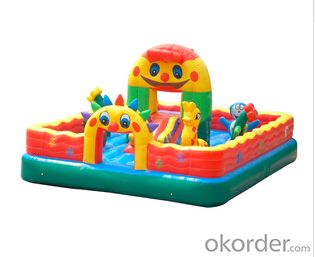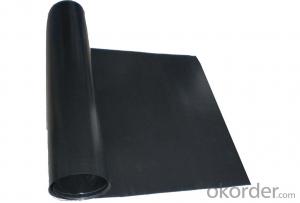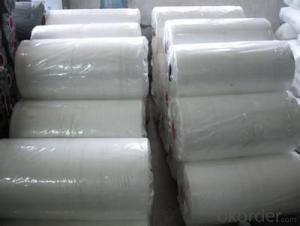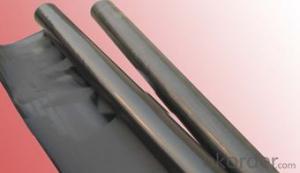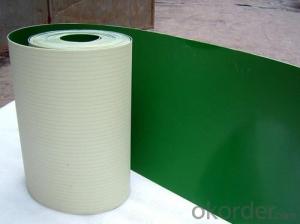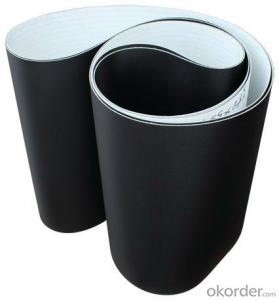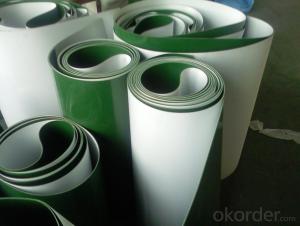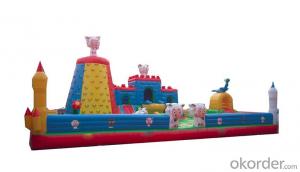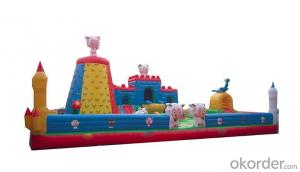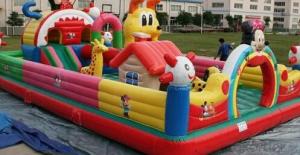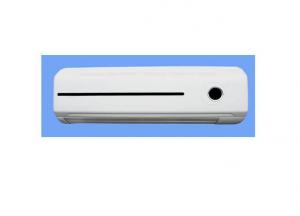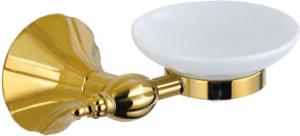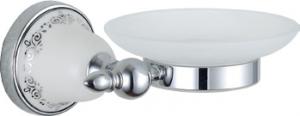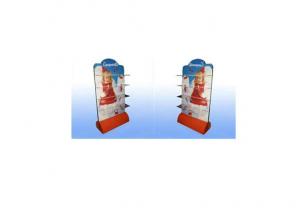Funny inflatable dignity fancy jumping castle
- Loading Port:
- Shanghai
- Payment Terms:
- TT OR LC
- Min Order Qty:
- 10 set
- Supply Capability:
- 10000 set/month
OKorder Service Pledge
OKorder Financial Service
You Might Also Like
Specification:
size:other customized sizes available
colors:As customized
material:0.55 mm PVC tarpaulin /plato
MOQ:10pc
packing:PVC bags for items , carton box for blowers
Produce Time:7-15 working days after deposit of payment received
Shipping way: By sea /by air/by DHL
weight:Accordingly
warranty:2 years
blower:CE/UL and free of charge
certificate:EN71/SGS/CE/UL/Lead free/ EN14960
printing:Logo/ Banner/web site /phone/company name and so on all availabe
OEM AND ODM:ACCEPTED
Quality control:1. Double stitching throughout the unit with triple stitching
2. Quadruple stitching in key areas inside the base. Extra webbing reinforced strip on all the stress points and interior panels
Come with:1. 2 years warranty 2. FREE blower(if customer want to buy the blower) 3. repair kits 4.Safe rule 5.Banner with your phone No/company name
- Q: Do olive nets protect against pests other than olive fruit flies?
- No, olive nets are specifically designed to protect against olive fruit flies and are not effective against other pests.
- Q: How does an olive net affect the overall crop rotation practices?
- An olive net can positively impact overall crop rotation practices by providing protection to the olive trees during the harvest season. It helps prevent damage to the crop caused by falling olives or external factors such as wind, rain, or pests. This increased protection allows for a more reliable and consistent olive harvest, which in turn facilitates the implementation of effective crop rotation practices. With a stable olive crop, farmers can better plan and rotate other crops in their fields, optimizing soil health, minimizing disease and pest risks, and improving overall agricultural productivity.
- Q: What kinds of plastic pipes are divided into?
- The most widely used plastic pipe is plastic pipe. There are many kinds of plastic pipes, which are divided into two categories: thermoplastic pipes and thermosetting plastic pipes. It belongs to thermoplastic, including PVC pipe, polyethylene pipe, polypropylene pipe, POM pipe, super high molecular weight polyethylene pipe, etc. it belongs to thermosetting phenolic plastic pipe. The main advantages of plastic pipes are good corrosion resistance, light quality, convenient molding and easy processing. The disadvantages are low strength and poor heat resistance.
- Q: How can you increase the hardness of PE plastics?
- Is it HDPE or LDPE? You can add some calcium carbonate to improve the hardness.
- Q: How many kinds of plastic materials are there?
- According to the different uses of plastics is divided into general and engineering plastics in general plastic refers to the yield, low price and wide application range of plastics, mainly including polyolefin, PVC, polystyrene, phenolic and aminoplastic five varieties. Many of the products used in everyday life are made from these general plastics. Engineering plastics are plastics that can be used as engineering structural materials and instead of metals to make machine parts and components. Such as polyamide, polycarbonate, POM, ABS resin, PTFE, polyester, polysulfone, polyimide and so on. Engineering plastics has the characteristics of low density, high chemical stability, good mechanical properties, excellent electrical insulation, easy processing, widely used in automobiles, electrical appliances, chemical industry, machinery, instruments, and other industries, is also used in space navigation, missiles, etc..
- Q: Can olive nets be used for olive trees in cold climates?
- Yes, olive nets can be used for olive trees in cold climates. Olive nets serve multiple purposes such as protecting the trees from frost and cold winds, as well as preventing damage from heavy snowfall. They create a microclimate around the tree, helping to retain heat and provide insulation during cold weather. Additionally, olive nets can also be used to collect fallen olives during the harvest season, making them a versatile tool for olive tree cultivation in cold climates.
- Q: Are there any specific regulations or guidelines regarding the use of olive nets?
- Yes, there are specific regulations and guidelines regarding the use of olive nets. These regulations may vary depending on the country or region, but generally they cover aspects such as the size and mesh of the nets, their installation and maintenance, and the permitted duration of their use. These guidelines aim to ensure the protection of olive trees, prevent environmental harm, and promote sustainable harvesting practices. It is important for olive farmers and harvesters to familiarize themselves with the specific regulations and guidelines in their area to ensure compliance and responsible use of olive nets.
- Q: Can olive nets be used in regions with high humidity levels?
- Yes, olive nets can be used in regions with high humidity levels. However, it is important to consider the type of net material used and ensure that it is resistant to moisture and mold growth. Additionally, regular maintenance and proper drying of the nets after use may be necessary to prevent damage and maintain their effectiveness.
- Q: Are olive nets safe for wildlife?
- Yes, olive nets are generally safe for wildlife. They are designed to protect the olives from birds and other animals, without causing harm to the wildlife. The nets are typically made of lightweight material and have small openings to prevent entanglement or injury to birds and other animals. Additionally, olive harvesting is usually done during the non-breeding season of many bird species, further minimizing any potential impact on wildlife.
- Q: How much do olive nets typically cost?
- The cost of olive nets typically varies depending on factors such as the size, quality, and material of the net. On average, olive nets can range from $10 to $50 per net.
Send your message to us
Funny inflatable dignity fancy jumping castle
- Loading Port:
- Shanghai
- Payment Terms:
- TT OR LC
- Min Order Qty:
- 10 set
- Supply Capability:
- 10000 set/month
OKorder Service Pledge
OKorder Financial Service
Similar products
Hot products
Hot Searches
Related keywords
